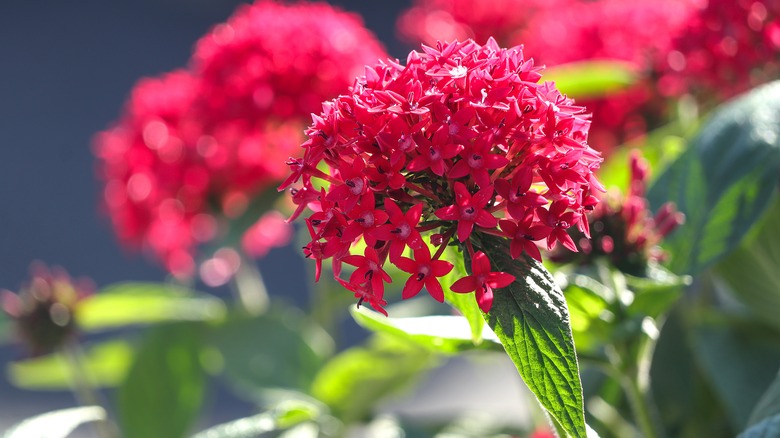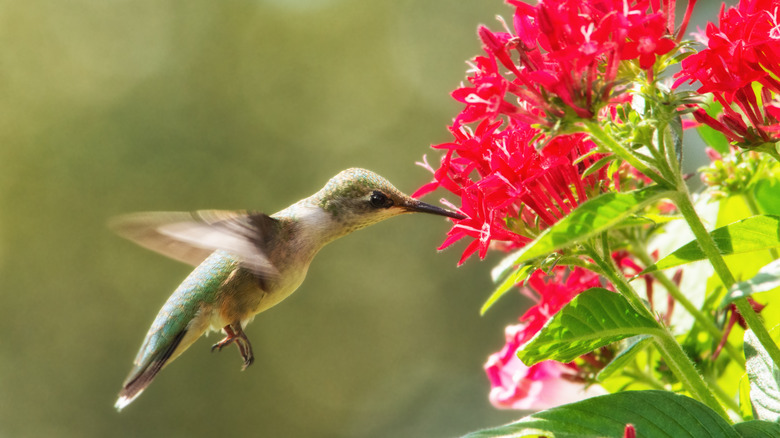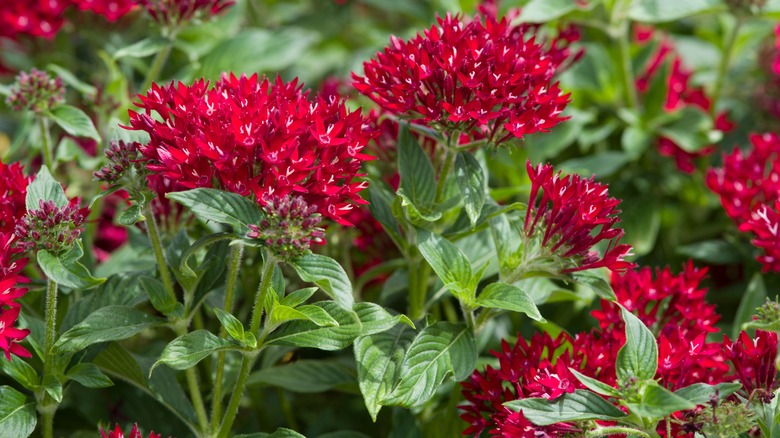Tips To Create Long-Lasting Blooms On Pentas Flowers
Pentas (Pentas lanceolata) also known as Egyptian star clusters or star flowers, are stunning plants with vibrant bursts of color famed for their summer-long blooms. This easy-to-care-for flowering plant that hummingbirds love looks beautiful in containers or directly in a garden bed. However, to keep these beauties blooming, there are a few tips and tricks you'll want to implement, including fertilizing and deadheading them regularly. Although they're flowers even the worst gardener can handle, they still have some growth preferences to adhere. The extra attention to detail is worth the effort, as these star-shaped clusters provide lots of nectar, making them a pollinator hotspot.
Native to eastern Africa and the Arabian peninsula, pentas are hardy in zones 10 to 11, though they're grown as annuals in cooler climates. You can start the seeds indoors over the winter, within 10 weeks of the expected final frost in your area. Whether you grow from seed or purchase mature plants, make sure you plant them outside in spring, when the soil warms up and there's no risk of frost. They like a little space away from one another, so plant them at least 1 foot apart. This gives them plenty of room to spread, with mature plants reaching 2 to 3 feet wide. That said, it's okay to plant them a bit closer if growing in containers. Choose a location in your garden that receives full sun. While they can live in partial shade, giving them at least six hours of direct sunlight will promote the best blooming.
How often should you water and fertilize pentas?
Although plenty of sunlight is one of the main ingredients required to encourage pentas blooms, it isn't the only factor to consider. While it's true pentas are fairly drought-tolerant, they prefer well-drained soil that's consistently moist. Supplemental watering during long stretches without rainfall will help deliver the nutrients they need to keep producing blooms. Keep in mind, however, that pentas are prone to root rot, a fungal condition often caused by overwatering. So, don't make the mistake of giving them too many showers in an attempt to get more blooms, or it'll cause more harm than good.
These flowering annuals will last all summer with the right care. Part of caring for pentas is giving them proper fertilization. How often you fertilize star flowers will depend on the type you choose. However, we recommend applying a balanced liquid fertilizer every four to six weeks to maintain the blooms. Seeing results from the extra food can cause some excited gardeners to want to fertilize more often. Unfortunately, overfertilization can cause the opposite effect. Plants can only absorb so many nutrients, so what's leftover will build up in the soil. The accumulation of food in the soil can burn the roots, which impacts how much water they can drink. This can cause stunted growth and even loss of blooms. Aside from an unhealthy plant, you may notice a white crusty build-up on the soil if you're using too much fertilizer.
Encourage blooms by deadheading and pruning
Deadheading is one of the most effective ways to encourage your pentas to put out more flowers. Unlike some flowering plants, pentas aren't self-cleaning, so they need a little help disposing of their spent blooms. Not only does removing old growth keep your plants looking their best, but it allows your pentas to allocate their energy more efficiently. Rather than putting effort into seed production on wilted flowers, they put them toward producing new, vibrant blooms. Keeping up with deadheading throughout the growing season makes sure you receive a continuous burst of colorful flowers in your garden.
When deadheading or pruning, make sure you use a sharp, sanitized pair of pruning shears or scissors. Cut directly below the wilted bloom and above the foliage. However, if the stem also appears to be dead, you can remove that too. Pruning is also a crucial step to keep your pentas blooming all season. If your pentas looks crowded, thin out some of the branches to improve air circulation. It's also a good idea to snip any areas that look long and woody, especially if you're growing them as perennials. Cutting back in the winter or spring will result in a bushier plant with more flowers to enjoy the next year. Keep in mind, when growing pentas as annuals, they'll need to be dug out and placed in a sunny area indoors to survive the winter. You can also take cuttings for a more manageable overwintering method.


